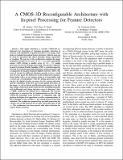Por favor, use este identificador para citar o enlazar a este item:
http://hdl.handle.net/10261/84172COMPARTIR / EXPORTAR:
 SHARE
BASE SHARE
BASE
|
|
| Visualizar otros formatos: MARC | Dublin Core | RDF | ORE | MODS | METS | DIDL | DATACITE | |

| Título: | A CMOS-3D reconfigurable architecture with in-pixel processing for feature detectors |
Autor: | Suárez, Marta CSIC ORCID; Brea, V. M.; Pardo, F.; Carmona-Galán, R. CSIC ORCID ; Rodríguez-Vázquez, Ángel CSIC ORCID | Fecha de publicación: | 2012 | Editor: | Institute of Electrical and Electronics Engineers | Citación: | IEEE International 3D Systems Integration Conference: 1-8 (2012) | Resumen: | This paper introduces a two-tier CMOS-3D architecture for generation of Gaussian pyramids, detection of extrema, and calculation of spatial derivatives in an image. Such tasks are included in modern feature detectors, which in turn can be used for operations like object detection, image registration or tracking. The top tier of the architecture contains the image acquisition circuits in an array of 320 × 240 active photodiode sensors (APS) driving a smaller array of 160 × 120 analog processors for low-level image processing. The top tier comprises in-pixel Correlated Double Sampling (CDS), a switched-capacitor network for Gaussian pyramid generation, analog memories and a comparator for in-pixel Analog to Digital Converter (ADC). The reuse of circuits for different functions permits to have a small area for every pixel. The bottom tier of the architecture contains a frame buffer with a set of registers acting as a frame-buffer with a one-to-one correspondence with the analog processors in the top tier, the digital circuitry necessary for the extrema detection and the calculation of the first and second spatial derivatives in the image, as well as Harris and Hessian point detectors. For the time being, a behavioral model of the first tier including mismatch and feedthrough and charge injection errors is discussed. Also, a VHDL model for the bottom tier is addressed. The two-tier architecture is conceived for its implementation on the 130 nm CMOS-3D technology from Tezzaron. A companion chip will perform the higher-level operations as well as communications. In this technology an area of 300 μm2 per analog processor has been estimated. The architecture proposed for pyramid generation lets a frame rate of 180 frames/s for an ADC conversion time of 120 μs. The architecture has been proved with object detection for a given feature detector. | Descripción: | Trabajo presentado al 3DIC celebrado en Osaka del 31 de enero al 2 de febrero de 2012. | Versión del editor: | http://dx.doi.org/10.1109/3DIC.2012.6263019 | URI: | http://hdl.handle.net/10261/84172 | DOI: | 10.1109/3DIC.2012.6263019 | Identificadores: | doi: 10.1109/3DIC.2012.6263019 isbn: 978-1-4673-2189-1 |
| Aparece en las colecciones: | (IMSE-CNM) Libros y partes de libros |
Ficheros en este ítem:
| Fichero | Descripción | Tamaño | Formato | |
|---|---|---|---|---|
| A CMOS-3D.pdf | 858,14 kB | Adobe PDF |  Visualizar/Abrir |
CORE Recommender
Page view(s)
458
checked on 24-abr-2024
Download(s)
266
checked on 24-abr-2024
Google ScholarTM
Check
Altmetric
Altmetric
NOTA: Los ítems de Digital.CSIC están protegidos por copyright, con todos los derechos reservados, a menos que se indique lo contrario.
